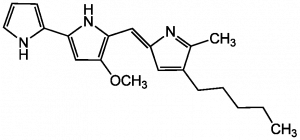Prodigiosin (PG) is a secondary metabolite – a red pigment and a typical alkaloid compound that is produced by microorganisms such as Serratia marcescens of the order Eubacteriales and other Gram-negative bacteria, gamma proteobacteria (Vibrio psychroerthrus and Hahella chejuensis). It could be an alternative natural pigment using fermentation methodology to produce it at a competitively priced level. It would also reduce the dependency on synthetic colours in both the food and textile industries.

Prodigiosin belongs to a group of pigments that also have a variety of benefits:- antibacterial (Alihosseini et al., 2008), insecticidal (Wang et al., 2012) and antitumor (Chang et al., 2011) based. Other prodigiosin type pigments include norprodigiosin, a dipyrrolyl-dipyrromethene derivative and cyclononylprodigiosin.
References
Alihosseini, F., Ju, K.S., Lango, J., Hammock, B.D., Sun, G. (2008) Antibacterial colorants: characterization of prodiginines and their applications on textile materials. Biotechnol. Prog. 24 pp. 742–7.
Chang, C.C., Chen, W.C., Ho, T.F., Wu, H.S., Wei, Y.H. (2011) Development of natural anti-tumor drugs by microorganisms. J Biosci. Bioeng. 111 pp. 501–11.
Wang, S.L., Wang, C.Y., Yen, Y.H., Liang, T.W., Chen, S.Y., Chen, C.H. (2012) Enhanced production of insecticidal prodigiosin from Serratia marcescens TKU011 in media containing squid pen. Process Biochem. 47 pp. 1684–90.
Leave a Reply